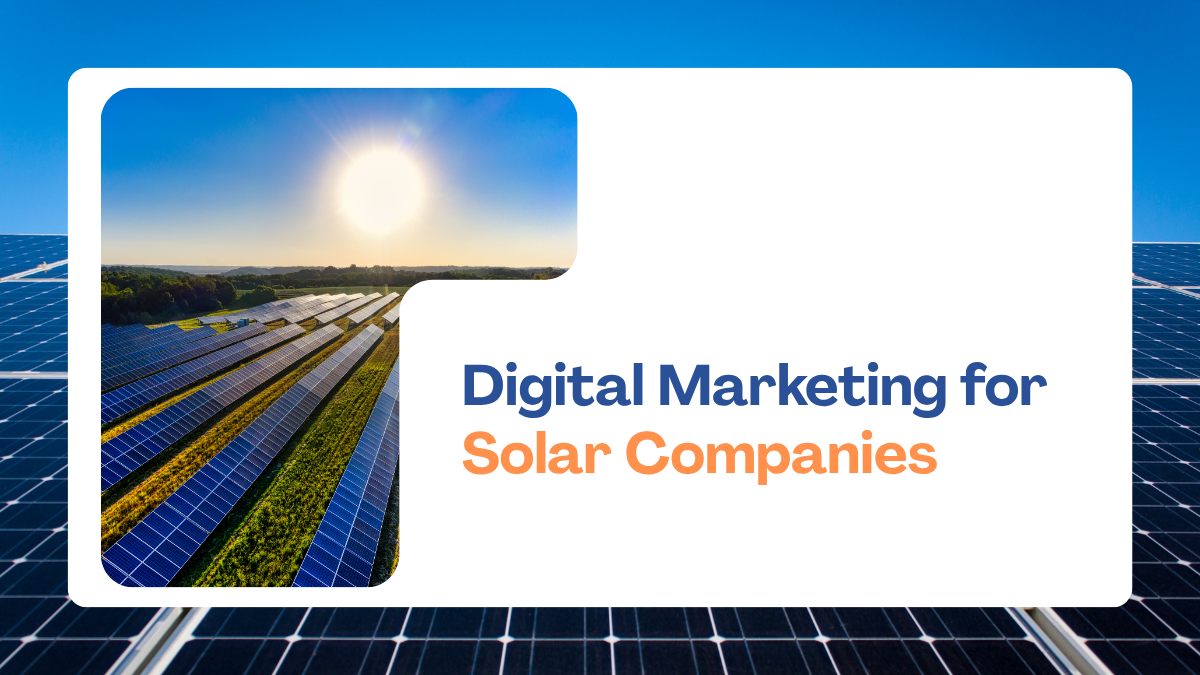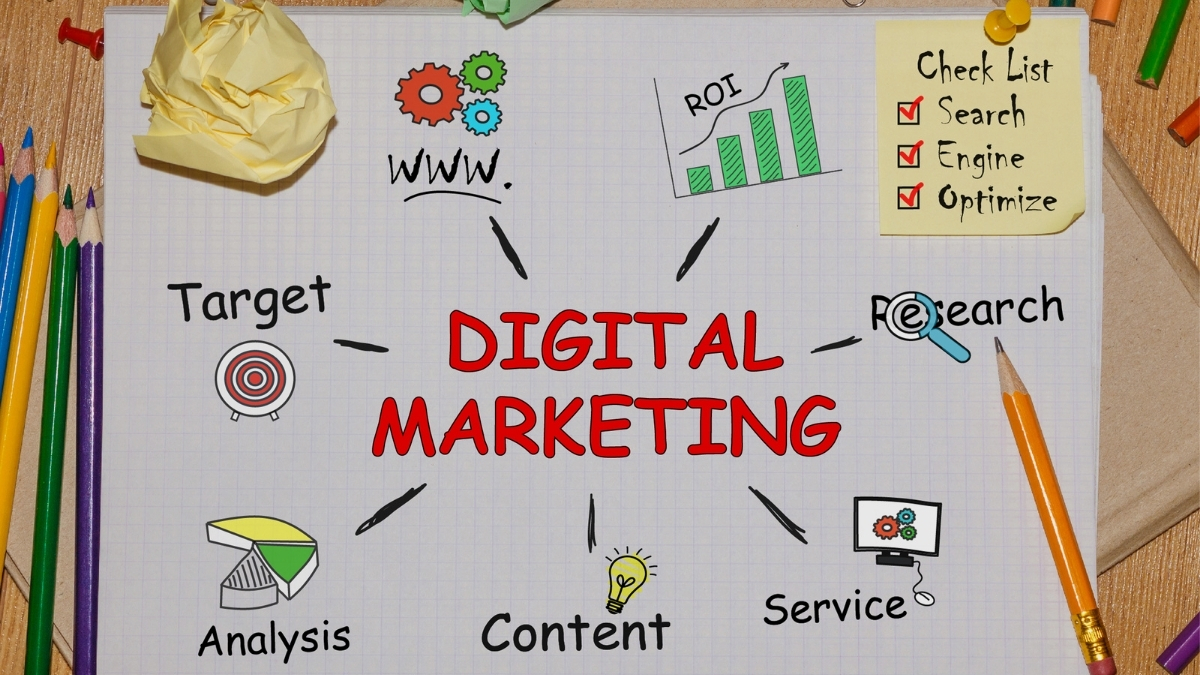
Digital Marketing for Solar Companies
The sun is a powerful, reliable source of energy. But is your marketing just as powerful? For many solar companies, the answer is no. You might have the best panels and the most skilled installation team, but if homeowners can't find you online, you're leaving a lot of money on the table.
This guide is here to change that. We're going to walk through how digital marketing can help your solar business shine online. You'll learn the essential strategies that generate leads, build trust, and grow your company—but we’ll also dig deeper into advanced tactics, real-life examples, and smart ways to measure your success. Whether you’re just starting or looking to level up your online presence, there’s something here for every solar business.
Why Digital Marketing Matters for Solar

Think about how people make big purchase decisions today. They don't flip through the Yellow Pages; they go online. They search for "solar installers near me," read reviews, and compare companies on their websites. If you aren't visible in these digital spaces, you're essentially invisible to a huge pool of potential customers.
Digital marketing allows you to:
-
Target homeowners in specific zip codes who have shown interest in renewable energy.
-
Share your expertise, showcase successful projects, and let customer testimonials do the selling for you.
-
Solar is a big investment. Use digital content to answer questions, explain the benefits, and guide potential customers through the decision-making process.
-
Instead of casting a wide, expensive net with traditional ads, digital marketing brings interested, ready-to-talk leads directly to you.
-
Through remarketing and email, you can continue engaging with interested prospects until they’re ready to make a decision.
Key Digital Marketing Strategies for Solar

Let’s break down the most effective digital marketing channels for a solar company. You don’t need to do everything at once. Start with one or two and grow from there.
Search Engine Optimization (SEO)
SEO is the art and science of getting your website to show up on the first page of Google when someone searches for terms related to your business. This is arguably the most important strategy for long-term, sustainable lead generation.
How it works for solar: When a homeowner searches for "solar panel cost Texas" or "best solar company in Phoenix," you want your website to be one of the top results. SEO makes that happen.
Practical Tips:
-
Focus on Local SEO: Most of your customers will be in your service area. Make sure you have a "Google Business Profile" set up with your address, service areas, hours, and real project photos. Ask happy customers to leave detailed reviews that mention their city and the type of project you completed.
-
Find Your Keywords: Think like your customer. What would they type into Google? Use tools like Google’s Keyword Planner or Ubersuggest to find terms like "solar installation [your city]," "how much do solar panels save," or "residential solar incentives."
-
Create Helpful Content: Write blog posts and website pages that answer common customer questions. For example, dedicate a page to "The Solar Installation Process in [Your State]" or a blog about "Understanding Your Electric Bill After Solar."
-
On-Page SEO: Make sure each page on your website is optimized for both your target keywords and user experience. Include location information, a call to action, and important details like certifications or partnerships.
-
Technical SEO: Ensure your website loads quickly, is mobile-friendly, and has a secure connection (HTTPS). These factors impact how high you appear in search results.
Case Example:
SolarTech Midwest invested in updating their site structure and blog topics based on popular search questions in their area. By adding before-and-after project galleries and city-specific testimonials, their organic traffic increased by 65% in six months, resulting in three times more quote requests.
Content Marketing
Content marketing is about creating and sharing valuable, relevant information to attract and retain your target audience. For solar, this means educating homeowners and positioning your company as a trusted expert—and it can drive both organic SEO and customer engagement.
How it works for solar: Instead of just saying "Buy our panels," you create content that helps customers understand the benefits of going solar. This builds trust and keeps your company top-of-mind when they are ready to buy.
Practical Tips:
-
Write articles that address the top questions your sales team gets, such as "Are Solar Panels Worth It in [Your State]?" or "A Guide to Federal Solar Tax Credits."
-
Showcase a recent installation. Include photos of the home, details about the system size, and a quote from the happy homeowner about their new, lower electricity bill. This kind of social proof is powerful.
-
Add an interactive tool to your website where visitors can input their average electric bill and see how much they could save with solar. This is also an excellent lead-generation tool.
-
Create short videos explaining the installation process, showing system monitoring apps, or introducing your team. Upload them to YouTube and embed them on your website.
Advanced Tip:
Produce downloadable guides, checklists, or infographics that people can reference and share. Encourage visitors to exchange their email address for access, building your list and establishing your expertise.
Mini Case Study:
SunRise Installers published a “Beginner’s Guide to Going Solar” eBook and promoted it via their website and social channels. In return for an email address, prospects could download the guide. They grew their email list by 450 subscribers in one quarter and converted 18% of those into sales meetings.
Social Media Marketing
Social media gives your brand a human voice. It’s less about hard selling and more about building a community and sharing your story. Platforms like Facebook, Instagram, and even TikTok are surprisingly effective for solar companies.
How it works for solar: Use social media to share photos and videos of your team in action, post testimonials from happy clients, answer questions in comments, and run targeted ads to homeowners in your area.
Practical Tips:
-
Show, Don’t Just Tell: Post high-quality photos and videos of your finished projects. Before-and-after shots of a roof or a time-lapse of an installation are very engaging.
-
Spotlight Your Customers: With permission, share a photo of your customers next to their new solar array. Tag them and celebrate their switch to clean energy.
-
Use Facebook and Instagram Ads: Ad targeting is powerful—you can reach users by location, homeownership status, interests like "renewable energy," and even retarget website visitors.
-
Leverage User-Generated Content: Encourage happy customers to share their own photos and tag your company for a chance to be featured on your page.
-
Engage With Your Community: Answer questions, run polls, and celebrate milestones such as your 100th installation.
Real-World Example:
BrightPath Solar started using Instagram Stories to showcase day-to-day operations, quick Q&A sessions, and on-site project progress. They noticed significant upticks in DM inquiries and website clicks from viewers who enjoyed seeing the real people behind the panels.
Email Marketing
Email marketing is a direct and personal way to nurture leads and stay in touch with past customers. It’s your “owned” channel—not at the mercy of algorithm changes.
How it works for solar: Someone downloads a guide from your website or uses your savings calculator. Now you have their email. You can send them automated emails that further educate them on solar, share testimonials, and invite them to schedule a free consultation.
Practical Tips:
-
Give people a reason to share their email address. A free PDF guide like "5 Things Every Homeowner Should Know Before Going Solar" works well.
-
Set up a series of 3–5 emails for new leads. The first gives the guide, the next shares a case study, the third answers common questions, and the final one invites them to connect.
-
Send a quarterly newsletter with company updates, maintenance tips, referral incentives, or seasonal reminders (like tips for cleaning panels).
Advanced Tips:
-
Group your list by stage (new lead, in-progress, customer) or interest (commercial vs. residential). This lets you send the most relevant content for each group.
-
Use your contacts’ names and, if possible, reference their local weather or electricity challenges. Personalized subject lines and content get better open rates.
-
If someone requests a quote but doesn’t follow up, send a friendly automated reminder email a week later.
Case Study:
GreenVolt Solutions noticed inactive leads were slipping away. They set up an automated “reactivation” email series with progress stories and updated financing options. Over three months, they re-engaged 16% of dormant contacts and closed five sales from the old list.
Paid Advertising (PPC & Display Ads)
While organic strategies are great for long-term growth, paid ads on Google and social media can generate immediate leads and scale quickly during peak seasons.
How it works for solar: With Google Ads, your company appears at the top of search results for buying-intent keywords like “solar installer near me.” Display ads can be used for remarketing—showing your ads to visitors who didn’t convert the first time.
Practical Tips:
-
Set a Sensible Budget: Start small, test your campaigns, and increase your spend based on cost-per-lead.
-
Target Location and Intent: For the best results, limit your keywords and ad geography to your serviceable area and high-buying intent phrases.
-
Use Conversion Tracking: Link your ads to landing pages with contact forms and track how many leads each ad produces.
Pro Example:
Bright Energy Pros ran Google Ads on “solar quote Houston” and retargeted site visitors on Facebook. This two-pronged campaign reduced their cost-per-acquisition by 30% and boosted booked appointments in the slow season.
Online Reputation Management
Your reviews are often the first thing new prospects see—sometimes even before they visit your website. Proactively managing your reputation is crucial.
How to approach it:
-
The best time is right after a positive installation experience. Train your team to mention it during wrap-up or in a follow-up email.
-
Thank reviewers—good or bad—for their input. Address negative reviews with empathy and a willingness to resolve issues.
-
Showcase authentic testimonials on your homepage and service pages. Include customer names and, if possible, photos of the installation.
Case Illustration:
EcoSun Power included a QR code in their post-install folders that linked directly to their Google review page. Their monthly review average doubled, and they landed multiple leads who cited "great reviews" as the reason for contacting them.
Measuring Digital Marketing Success

To get the most from your efforts, you need to know what’s working (and what’s not). Here are practical ways to measure your digital marketing:
Key Metrics to Track
-
Website Traffic: Monitor visits, bounce rates, and time-on-site using Google Analytics.
-
Lead Conversion Rate: Track how many visitors fill out your contact form or call after clicking an ad or viewing a landing page.
-
Cost Per Lead (CPL): Divide your total digital marketing spend by the number of leads generated.
-
Keyword Rankings: Use a tool like SEMrush or Moz to track your website’s ranking for the most important search phrases.
-
Email Engagement: Look at open rates, click-through rates, and unsubscribes.
-
Social Engagement: Track likes, shares, comments, and new followers.
Advanced Tips for Measuring Success
-
Set Up Goal Tracking: Use Google Analytics to set up conversions for form submissions, clicks to call, or downloads.
-
Call Tracking: Use a phone service that assigns unique numbers to your ads or landing pages so you can trace which marketing tactics actually drove the call.
-
CRM Integration: Connect your marketing data to a simple CRM system (like HubSpot or Zoho) to see which marketing channels bring in your most valuable customers.
More Real-World Case Studies
Case Study: Rooftop Renewables
A regional solar installer found that 77% of its website traffic came from mobile devices. They revamped their site for mobile-first design, simplified their quote request process, and used click-to-call buttons on every page. Result: online form submissions increased by 140%, and call-in leads increased by 50%.
Case Study: Sunshine Homes Solar
They piloted short “customer journey” videos—clips of customers sharing their installation stories and energy bill drops. The videos, shared on Facebook and YouTube, were responsible for a 40% bump in social engagement and correlated with a 22% rise in sales inquiries during the campaign.
Final Thoughts
Digital marketing isn’t a magic button, but it is a proven framework for growing a solar business in the modern world. With the right mix of strategies—from SEO and content, to paid ads and email nurturing—you can reliably connect with motivated homeowners and close more deals.
You don’t have to become a digital expert overnight.
Start small: choose a couple of tactics, set goals, and track your results. Over time, you’ll discover which strategies work best for you and your audience. With consistency and focus, your “marketing engine” will work around the clock, helping your solar company grow—rain or shine.
30 minutes
Expert Consultation
Terms & Agreements
By booking a free 30-minute consultation, you agree to our terms, including scheduling, cancellation policies, and confidentiality. The session provides expert advice without guarantees of specific outcomes or results.






Leave a Reply
Your email address will not be published. Required fields are marked *